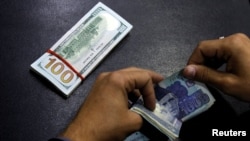For the first time in Pakistan’s history, the country’s currency plummeted in value to more than 300 rupees against the dollar, raising fears that everyday items could get more expensive as consumers continue to face back-breaking inflation.
The latest plunge came Thursday after two days of record lows. The Pakistani rupee has lost more than a third of its value against the U.S. dollar in the last year as the country struggles under mounting debt.
Experts say the rupee is depreciating as demand for the dollar is increasing after import restrictions, imposed by the government last year to save dwindling dollar reserves, ended in June.
“Because imports were not happening, we were able to prop up the value of the rupee, kind of artificially, against the dollar,” economist Ammar Habib Khan told VOA. Khan is a Pakistan-based nonresident senior fellow at the Washington-based Atlantic Council.
Opening up imports was a condition for Islamabad to secure a much-needed $3 billion bailout from the International Monetary Fund. The deal came in July after several rounds of tough negotiations during which the lender demanded massive economic reforms.
Saving Pakistan from default, the deal paved the way for billions in loans and investment from longtime allies China, Saudi Arabia and the United Arab Emirates, boosting dollar reserves.
The average Pakistani is struggling to make ends meet, however, as inflation hovers around 29 percent. Slashing subsidies to secure IMF funds sent fuel prices to an all-time high, while electricity continues to become more expensive despite a drop in demand.
Syed Ali Hasanain, associate professor at the Lahore University of Management Sciences, told VOA the sustained decline in the value of the rupee shows Pakistan is struggling to improve its balance-of-payment crisis.
“The country has long imported more than it has exported, as a consequence of neglecting structural reforms for decades,” Hasanain said.
Pakistan, a country of roughly 240 million people, relies heavily on imports. While restricting imports helped save precious dollar reserves, it also caused a decline in exports, as manufacturers rely on imported machinery and raw material for production.
The country is reeling from last year’s historic floods, severe political instability and the economic shocks of the COVID-19 pandemic.






